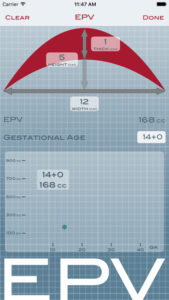My First Trimester
Week 7
Estimated reading time: 7 min reads Seven weeks into your pregnancy, or five weeks after conception, your baby’s brain and face are rapidly developing. Tiny nostrils become visible and the lenses of the eyes begin to form. The arm buds which sprouted last week now take on the shape of paddles.
Seven weeks into your pregnancy, or five weeks after conception, your baby’s brain and face are rapidly developing. Tiny nostrils become visible and the lenses of the eyes begin to form. The arm buds which sprouted last week now take on the shape of paddles.
You baby is now cushioned by a thin membranous sac and will be immersed in amniotic fluid during your pregnancy. The baby will be protected from all but the most severe jolts while floating buoyantly in temperature controlled surroundings.
Little edges now appear signaling that tiny fingers and toes are beginning to emerge on the buds that are developing into baby’s extremities. Facial features are marked by hollowed areas on the face.
Internal organs are in place although not completely developed nor operating on their own just yet. Your baby has nearly grown twofold as blood is circulating brilliantly through your baby from the liver.
By the end of this week, your baby might be a little bigger than the top of a pencil’s pink eraser.
Estimated Placental Volume (EPV)
“Estimated Placental Volume (EPV) should be incorporated into prenatal care” explains Yale Researcher, Harvey J. Kliman, MD, PhD. Dr. Kliman is the Director of the Reproductive and Placental Research Unit Department of Obstetrics and Gynecology, Yale University School of Medicine and a member of PAK’s Medical Advisory Committee (MAC.) EPV is calculated using a simple 2-dimensional ultrasound to assess the ratio of baby to placenta. Kliman states, “Docs should know about abnormal placentas. Not knowing anything about a placenta is like driving a car without a gas gauge!”

It’s during Week 6 that minuscule tassel-like fingers called Chorionic Villi are forming on the outer layer of the embryo becoming the first part of your baby’s lifeline to you. These tiny structures will collectively in time form the placenta. While the placenta is growing, the second part of your baby’s critically essential lifeline, the umbilical cord, is also developing. In order for your baby to flourish in utero, both the placenta and umbilical cord must be watched and monitored throughout your pregnancy to help ensure continued wellbeing and a healthy delivery.
The Small Placenta
So why measure the placenta? Did you know that a standard prenatal ultrasound typically measures the baby, internal organs and placenta location – but not placenta size? It’s a scientific fact that a baby can outgrow his or her placenta anytime during pregnancy. A small placenta will not provide the nutrients and oxygen necessary to survive and thrive in utero. EPV is a placental screening tool that’s easily calculated during ultrasounds between Weeks 7 and 40 by your health care team. The potential to save lives by drawing attention and awareness to EPV will help close this alarming gap in prenatal care.
Measure the Placenta
Measuring your baby’s placenta is quick and easy! Your health care team will take three simple measurements of the placenta every time you have an ultrasound. The width, height and thickness measurements are input into Merwins Calculator, a FREE app for both iPhone and iPad and Android Smart Phones designed by Dr. Kliman and his father, Merwin Kliman. Merwin’s Calculator calculates the volume of a spherical cap from an imaginary cross section through the middle of the cap using a complex polynomial. In simple terms, the spherical cap, placed against the normative curve for placenta size by gestational age, gives you your baby’s EPV!
This is how it works:
- Enter the gestational age in weeks and days.
- Easily enter width, height and thickness of the spherical cap (placenta).
- Calculates EPV immediately using mathematical modeling.
- The volume result is immediately plotted on a sample normative curve, with the normal values in green and alert values in red.
- Additional EPV data points are plotted on the same graph so the patient and healthcare providers can see the progress of EPV throughout the pregnancy.
- EPV displayed in “cc” units relative to the range for your baby’s gestational age, highlights whether the measurement is:
- Within the standard range
- Below 10th percentile
- Above 90th percentile
- Results can be easily shared; data can be easily updated and recalculated, or cleared for a new sample.

If your health care team’s office is using a Mac desktop computer, the Merwins Desktop Calculator app will be an extremely useful office tool as it enables calculation of EPV, sharing, printing, and much more. The necessary information and guide to perform EPV is competent and clear making this step a fast add on for every ultrasound that you have! Please contact Dr. Kliman for more information regarding normative curves. You can take this informative printout for your health care team with you to your visit.
Small Placenta Complications
A small placenta may present complications that do not occur suddenly. Recent research at Akershus University Hospital (Ahus) in Norway conducted by Dr. Sandra Larsen highlights a newly found link between the weight of the placenta and the risk of preeclampsia, a condition that can be very serious for both mother and baby. She also noted that the placental size indicates an increased risk of preeclampsia in future pregnancies.
One complication of a significantly small placenta determined by EPV is Intrauterine Growth Restriction (IUGR). IUGR means that the baby is smaller than expected for the number of gestational weeks, weighs less than 9 out of 10 babies of the same gestational age, and the overall size of the baby and the growth of organs, tissues, and cells may also be affected.
An undiagnosed small placenta can have devastating results. The most severe being an intrauterine fetal demise (stillbirth.) “A placenta that is smaller or larger than normal in relation to the child’s birth weight increases the risk of fetal death,” states Dr. Larsen. These losses can be swift and unexpected as there are not always reduced movements or warning signs; too often these losses go unexplained.
Approximately half of the stillbirths in the United States result from conditions affecting the placenta. Based on current stillbirth rates, measuring the placenta has the potential to prevent thousands of stillbirths each year.
Be Empowered

Advocating for yourself and your baby is paramount! Measure the Placenta recognizes the opportunity of saving tiny lives by incorporating EPV measurements into standard prenatal care. Turing their devastating losses into proactivity, this organization’s amazing mothers and fathers locked arms with concerned citizens, researchers and providers to fulfill their mission by prudently informing every pregnant mom of the significance of measuring her baby’s placenta from her very first ultrasound!
If you would like to request that EPV be incorporated into your care or encourage your health care team to add EPV into their pregnancy ultrasounds or connect with one mom as she describes how her son became A Life Saved by Measuring the Placenta, Measure the Placenta is the perfect resource for you!
Ongoing Research
Your health care team may be interested in collecting your EPV data during your pregnancy and participating in an exciting EPV research study with Dr. Kliman. This study allows patients to share their EPV measurement data for ongoing research on the relationship between placental volume and a healthy pregnancy. The EPV ResearchKit app is free to download from the App Store. This app will not give you an EPV reading, but is designed to collect data during pregnancy. For an EPV reading, you will need to use Merwin’s Calculator app. The EPV ResearchKit App is not available for Android users presently.
 Speak with your health care team about becoming part of this exciting new study to ensure the wellbeing of your baby while proactively helping to secure your baby’s health on delivery day.
Speak with your health care team about becoming part of this exciting new study to ensure the wellbeing of your baby while proactively helping to secure your baby’s health on delivery day.
To learn more about the vital role of the placenta and the importance of keeping up-to-date with placental measurements at every ultrasound, visit Measure the Placenta and Dr. Kliman.